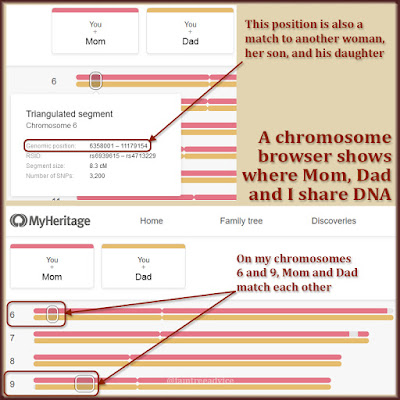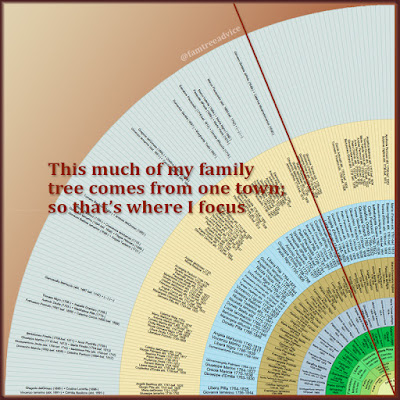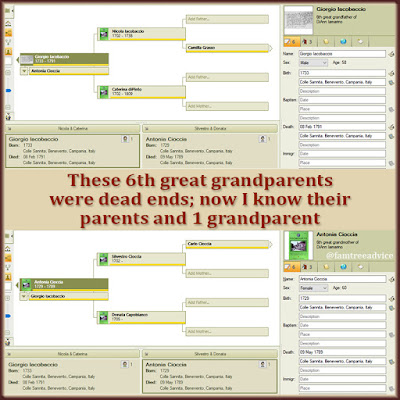Last week's virtual RootsTech conference can keep inspiring and teaching us all year. My main focus so far is the DNA lectures. Instead of watching them all one after another, I kept pausing to try out the techniques I was learning.
First I learned about chromosome browsers. I wish Ancestry.com would add one because I have the most cousin matches on that site. I learned how to triangulate matches with the chromosome browser on MyHeritage.com. I uploaded my DNA as well as my parents' DNA there long ago.
This lecture made me think of a long-standing mystery in my own DNA. A tool on GEDmatch told me my parents are related. They show up as each other's matches on Ancestry. The first thing I wanted to try on MyHeritage was a comparison of the 3 of us.
Once I logged into myheritage.com, I went to the DNA menu and chose DNA Tools, then Chromosome Browser. You can compare up to 7 DNA matches at a time to see exactly where you intersect.
But before I tried this, I had watched a lecture about pedigree collapse and endogamy. My remote ancestral Italian hometowns had tons of intermarrying of the families. In fact, even though they met and married in Ohio, my paternal grandparents were 3rd cousins.
When I was a kid, I thought it was a coincidence that Grandpa had the same last name as Grandma. No one said anything to me, but there's no way Grandpa Iamarino didn't know who his landlord was in 1927. He was Pasquale Iamarino—the 2nd cousin of Grandpa's father. Pasquale left Italy when Grandpa was a little boy, but they definitely knew they were family.
Because my grandparents were 3rd cousins, I have double ancestors belonging to both of them. That's the pedigree collapse.
This lecturer spoke about endogamy, when families intermarry for generations. Another lecturer explained that ethnic groups share certain DNA markers. That's how they determine your ethnic estimate. I had an "aha" moment, thinking this must be why Mom and Dad share some DNA. His people and her people came from neighboring Italian towns.
I thought the chromosome browser might show that my parents' relationship is only by place.
 |
| I used a chromosome browser to see exactly where Mom and Dad are related to each other. |
On MyHeritage, I compared myself to both Mom and Dad. I found 2 chromosomes where they matched me and one another! They call this triangulation. You can see it on the chromosome browser if you compare only 2 of your DNA matches at a time. It means my parents match one another as well as me.
I wondered if any of my other matches had an intersection in the same spots. I compared several matches on the chromosome browser with no luck.
Then I saw a match whose name I recognized. She's a woman from Grandpa's hometown in Italy, and her son and his daughter are all DNA matches to both my parents. I found that all 3 of them matched at the same exact location as my parents on my chromosome 6.
Through my research I found out the man in the group is my fifth cousin. (His daughter is my 5th cousin once removed.) But the relationship is on his father's side. Think about that. His mother matches us all in the same spot, but he's my cousin through his father and my father.
I wondered if either of my parents triangulated with any of these three people. I compared each of my parents to each of the three, one pair at a time. Here's what I found:
- The matriarch of the family triangulates with Dad only.
- Her son (my 5th cousin) triangulates with both Mom AND Dad!
- Her granddaughter triangulates with Dad only.
It's all a bit infuriating! I've gone very far on each of my parents' family trees. Their 37 shared centimorgans of DNA point to several possible relationships. I can rule out many because I know they do not share the common ancestor needed for these relationships.
 |
| How can this family be so intertwined with mine when the best we are is 5th cousins? |
All I can do is keep on fitting people from my ancestral hometowns into my family tree. Remember: You've got to document your ancestor's multiple marriages. The children from the second marriage could be your missing DNA link.
I'm also going to return to the RootsTech lectures and soak up as much information as I can about DNA. The quest continues.








